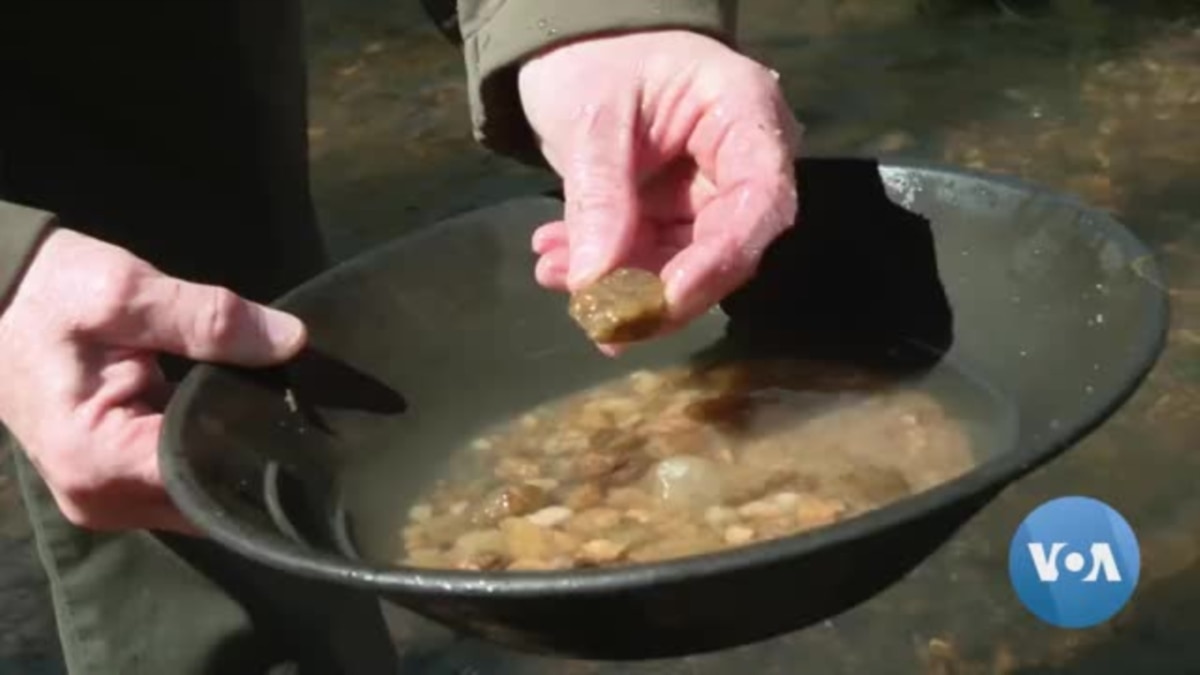Virginia Again Takes a Shine to Gold
by Steve Herman, Voice of America (VOA) News

Goldvein, Virginia – The Commonwealth of Virginia traces its roots to the perennial quest for gold. England's King James I chartered what would become the Virginia Company in 1606 in a colonizing pursuit of gold, spices and land. While land was abundant, there were no discoveries of spices or gold.
Renewed buzz about prospects for Virginia gold was prompted by a future U.S. president, Thomas Jefferson, publicizing in 1782 the discovery of a 1.8-kilogram gold-bearing rock on the north side of the Rappahannock River. But the precious metal was not found in abundance within the borders of Virginia until the early 19th century.

Gold mining in Virginia peaked as the third-largest producing state in the country yielded hundreds of commercial caches north of the James River in the 225-kilometer-long Pyrite Belt. Much of the gold from the state was shipped to the U.S. Mint in Philadelphia, helping to wean the young nation off foreign coinage and private tokens as legal tender. The Virginia boom went bust from 1848 when the California gold rush compelled serious speculators to go west.
Nowadays, there are limited opportunities in Virginia to experience gold fever. Fauquier County's Gold Mining Camp Museum, at Monroe Park in Goldvein, allows visitors to try their luck at a sluice after purchasing bags of gems. The park is also home to artifacts found at one of the 19 mines that operated within an eight-kilometer radius.
At Lake Anna State Park in Spotsylvania County, rangers escort visitors to a semi-clandestine spot adjacent to the old Goodwin gold mine to work a pan in a pond and see what washes up.
"I'm going to start to shake and agitate the material because I want the heavy gold to sink to the bottom," says chief ranger Lauri Schular as she demonstrates the basic technique with pan in hand at the park's Old Pond.
Those lucky enough to spot specks of gold will, however, leave empty-handed. All discoveries in the Virginia state park must remain on the premises.

Potential prospectors do get a consolation prize from Schular: a free lesson on the benefits of gold, which is a reliable and constant conductor of electricity that does not oxidize.
"That makes it great for all of our electronics that we want to close up and never open. So, don't go home and take things apart. It's not going to make you rich. It's a thin coating," she explains.
If you want to try to strike it rich in Virginia these days mining for gold, you are going to have to set aside the pan, invest in expensive equipment and persuade a landowner to allow you to prospect.
Paul Busch has accomplished that as Virginia's only licensed commercial miner and apparently the first one since the late 1940s.

Nineteenth century miners' trash is his treasure, piled high in Goochland County at the site of a mine with extensive mercury contamination that closed down in 1936. Back then, gold was worth around $35 an ounce (28.35 grams). These days it is about $2,000 an ounce.
"Anything under an ounce per ton on an average to them wasn't worth running and processing. They knew they were losing 50 to 60 percent of their gold in their tailings already. They could only process 20 tons in 24 hours," Busch, owner of Big Dawg Resources, explains, standing aside a hill of soil. "Any stone that was underground that they removed that was under an ounce per ton to them was garbage."
Busch is going through those piles of stones again with machinery he says can extract as much as $800 worth of gold a minute. He is also cleaning up the mercury contamination and filling in any pits and shafts that still may be hazardous.
"There's the potential for there to be a second gold mining boom to an extent" here, even though Virginia does not have large deposits, according to Busch. "For a small mining operation, there are a lot of veins out there that have been found over the years that could be highly profitable."
One new discovery in Buckingham County is attracting attention.
"You can see little specks of gold here and there," says Thomas Ullrich as he peers through a hand lens to inspect a specimen he has chipped off a big rock in Buckingham County.

Ullrich, a geologist and chief executive officer of Canada's publicly traded Aston Bay Holdings, has zeroed in on a quartz vein only two meters wide but spanning the length of a couple of city blocks. Several multi-ton boulders are visible above the surface. He discusses the potential of the site alongside one of those quartz-veined metavolcanic rocks that would likely yield nearly a couple of ounces of gold after extraction. At the current market rate, that would add up to nearly $4,000.
"Gold-bearing veins of ounce-plus grade, these have a value of tens to hundreds of millions of dollars. It's too early to say anything like that about anything here at Buckingham, but we are very encouraged by what we're seeing so far," Ullrich tells VOA.
"The success rate for prospects going to mine is very poor," Ullrich acknowledges. But based on what he has inspected in Buckingham County, "our odds are greatly improved here."
Steve Herman, formerly White House Bureau Chief, is now VOA's Chief National Correspondent.
The Resurgence of Gold Mining in Virginia
Virginia has a long history of gold mining, dating back to the early 1600s. The first gold rush in Virginia occurred in the 1700s, and the state produced over $1 million worth of gold during that time. However, gold mining in Virginia declined in the 1800s, and by the early 1900s, the industry had largely disappeared.
In recent years, there has been a resurgence of interest in gold mining in Virginia. This is due in part to the rising price of gold, as well as the discovery of new gold deposits in the state. In 2011, the Virginia General Assembly lifted a moratorium on gold mining, and since then, several companies have begun exploring for gold in the state.
The resurgence of gold mining in Virginia has been met with mixed reactions. Some people are excited about the potential economic benefits that the industry could bring to the state. Others are concerned about the environmental impact of gold mining, and they worry that the industry could damage the state's natural resources.
The Virginia Department of Mines, Minerals and Energy (DMME) is responsible for regulating gold mining in the state. The DMME has developed a set of regulations that are designed to protect the environment and ensure that gold mining is conducted in a safe and responsible manner.
The future of gold mining in Virginia is uncertain. The industry is still in its early stages, and it is not yet clear how much gold will be produced in the state. However, the potential economic benefits of gold mining are significant, and the industry could play a major role in the state's economy in the years to come.
Environmental Concerns
One of the main concerns about gold mining is the potential for environmental damage. Gold mining can pollute water supplies, contaminate soil, and damage wildlife habitats. In addition, gold mining can generate large amounts of waste, which must be disposed of properly.
The DMME is working to minimize the environmental impact of gold mining in Virginia. The agency has developed a set of regulations that require companies to minimize water pollution, prevent soil contamination, and protect wildlife habitats. In addition, the DMME requires companies to properly dispose of waste generated by gold mining.
Economic Benefits
The economic benefits of gold mining can be significant. Gold mining can create jobs, generate tax revenue, and boost the local economy. In addition, gold mining can provide a source of revenue for state and local governments.
The DMME estimates that the gold mining industry could generate up to $1 billion in economic activity in Virginia each year. The industry could also create up to 10,000 jobs. In addition, the DMME estimates that the gold mining industry could generate up to $100 million in tax revenue for state and local governments each year.
Conclusion
The resurgence of gold mining in Virginia is a complex issue with both environmental and economic implications. The DMME is working to minimize the environmental impact of gold mining, while also maximizing the economic benefits of the industry. The future of gold mining in Virginia will depend on the success of the DMME's efforts.

